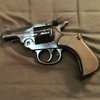Redcoat3340
Member
My oldest had a .38S&W K200 (38/200) that he never shot. I kinda glommed it off him. But I never shot it either.
Then I went looking for a topbreak revolver to add to my "collection" and came across an H&R "Defender" from 1947 that was in good shape and a bit underpriced. I bought it figuring with two in the caliber it made sense to buy some ammo.
Shooting them was really fun: .22-like recoil, some really interesting guns with some history; sort of elegant and delicate (not like my 38/44 Outdoorsman which is a beast); and mostly affordable.
I'm now up to 5 including the Defender, a 2 1/2" H&R 925, a Colt Police Positive, a S&W 33-1, and the 38/200 Smith. I'd like to add one more, a Smith "Perfected."
I know these are not for self defense (I've got enough in 38, 9 and 45 for that) but they are just such a joy to shoot. Pure range pleasure. The only downside is the ammo cost is more than .38 special. But I may get some dies and bullets, pull out the reloading gear and start rolling my own.
Anyone else find these a kick (to shoot or collect)?
(And yes, I know, unless there's pictures, it didn't happen. It's been a busy week but I'll try and get some shots.)
Then I went looking for a topbreak revolver to add to my "collection" and came across an H&R "Defender" from 1947 that was in good shape and a bit underpriced. I bought it figuring with two in the caliber it made sense to buy some ammo.
Shooting them was really fun: .22-like recoil, some really interesting guns with some history; sort of elegant and delicate (not like my 38/44 Outdoorsman which is a beast); and mostly affordable.
I'm now up to 5 including the Defender, a 2 1/2" H&R 925, a Colt Police Positive, a S&W 33-1, and the 38/200 Smith. I'd like to add one more, a Smith "Perfected."
I know these are not for self defense (I've got enough in 38, 9 and 45 for that) but they are just such a joy to shoot. Pure range pleasure. The only downside is the ammo cost is more than .38 special. But I may get some dies and bullets, pull out the reloading gear and start rolling my own.
Anyone else find these a kick (to shoot or collect)?
(And yes, I know, unless there's pictures, it didn't happen. It's been a busy week but I'll try and get some shots.)














